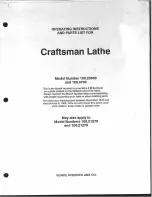
11
MAINTENANCE
For maximum performance, it is essential that the lathe be properly maintained.
Before Use
Always inspect before use. Any damage should be repaired and misadjustments rectified. Damage to machined surfaces should be repaired with
an oil stone. Test by hand to ensure smooth operation of all parts before use.
Apply a few drops of oil to the oil ways at both lead screw bearings (at each end bracket) and add more once or twice during the day if used
continuously. It will be necessary to remove the gear train cover in order to oil the left hand bearing.
Apply a few drops also to the compound slide oil way, located on the slides’ top surface, between the two socket head screws.
After Use
Remove all chips and debris from the machine and thoroughly clean all surfaces. If coolant has been used, ensure it has completely drained from
the tray. Components should be dry, and all machined surfaces should be lightly oiled. Always remove cutting tools, and store them in a safe place.
SETTINGS AND ADJUSTMENTS
Occasionally, it may be necessary to readjust various components in order to maintain optimum performance.
The adjustments that may be performed follow:
A. Cross-Slide Adjustments
The cross-slide is mounted on a dovetail slide, as shown in fig. 10. Between the sloping surfaces on
one side of the dovetail, a “gib strip” is inserted, which may be tightened against the dovetail using
three adjuster, or “gib,” screws mounted along its length.
The gib screws are to be found on the right hand side of the slide, directly beneath the compound slide
handle. In time, wear will occur on the mating surfaces, resulting in a “sloppiness” of action.
To adjust the gib strip to compensate for wear and ensure the slide moves evenly and smoothly,
proceed as follows:
Loosen all lock nuts and screw in the gib screws evenly; i.e., use the same torque for each screw.
The slide should be held firmly. Test by trying to turn the handle, but do not force it. Screw out each
gib screw by one quarter of a turn ONLY, and snug up the lock nuts
Test again by turning the handle. The movement should be even and smooth along its complete length.
If the movement is too loose, screw all adjusters “in” by 1/8 turn, and re-try. Similarly, if the movement is too stiff, screw “out” the adjusters by 1/8
turn until the correct adjustment is attained.
Tighten all lock nuts. Take care you do not move the gib screws while doing so.
When finished, retract the side fully and apply oil to all mating surfaces and the feed screw thread. Then crank the slide back to its normal position.
B. Cross-slide Feed Handle
The cross slide feed should run smoothly, and the scale must rotate with the handle.
If any stiffness occurs, it is probably the result of chips or other debris lodging between the mating surfaces. Undo the socket head screw which
secures the handle. Remove the handle and pull off the collar and the dial. Take great care to retain the small spring plate which sits in a groove
beneath the dial.
Clean the assembly and reassemble in reverse order. It will be necessary to hold the spring plate in place with a small screwdriver or similar tool,
and push down on it to allow the dial to be correctly located on the shaft.
C. Compound Slide Adjustments
Compound slide adjustments are made in the same way as those for the cross-slide. The gib screws are to be found on the left hand side of the
slide; i.e., facing the front of the lathe.
NOTE: It is important that the cross-slide and compound slide adjustments are correctly carried out and that there is no “sloppiness” of
action. Any misadjustments will have a serious effect on the quality of your work, as they will all be transferred to the tool tip. It is vital
that there is as little movement of the tool as possible.
10
























